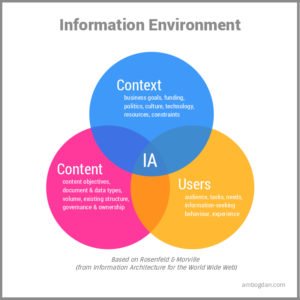
I’ve started my career some 15 years ago working as a copywriter for an advertising agency. It was great! Life, destiny, the unseen divine plan—call it as you like, offered me the chance to join OgilvyInteractive (2001) as an online copywriter. At that time, I didn’t know much about writing for the web. But, I was young, self-driven and really interested to explore new territories. I was the new kid on the team. The red-headed girl none of the tech guys would have expected to join the team. Not a really great start, one might think, yet it turned out really well. It’s there that I first discovered the Information Architecture (IA).
„Information architecture resembles the games of Othello and Go. A minute to learn, a lifetime to master.” Peter Morville
Loving Information Architecture
It was a time when you had no other choice but learn. Learn as much as you can and do the best to your knowledge. Learn about editing, writing for the web, about adding relevant links, content management and planning etc. Thanks to my dearest George Pogorelschi (CTO), I began my personal love affair with structures, labels, navigation elements and many more.
Little did I know that getting to know IA would be extremely helpful not just to my career, but also to all the papers I would later on write for my MA and MBA classes and all kinds of articles.
Hopefully, this very first article on Information Architecture exploring the definition of the discipline will give you something to think about, whether you are a student, a digital rookie, a copywriter or a marketer. The aim of the article is not to reveal all the secrets of IA. It would be an impossible task to achieve. Therefore, I decided to focus on defining information architecture.
Why would you care about IA
If you are a student, you know that best marks go to the assignments that show clear evidence of knowing how to combine a well-thought structure, with good capacity of analysis and synthesis, proper use of language, context, smart use of data, relevant resources and a final conclusion or recommendation for further research. If you get to think, that’s information architecture.
If you are a marketer or a digital strategist, you should already know by now that good websites bring true value to the business, which can be measured by either the growth of the notoriety of a brand, online sales, number of subscribers to the newsletter or the quantity of answers received to the online questionnaire, or the volume of questions addressed directly on the chat of the website to the representatives of the Customer Relation Department.
Achieving business goals & IA
Reaching those goals is not easy, as there are so many people involved, procedures to put in place, decisions to be made and so on, but we will not get into this right now. We’ll focus on just one aspect – when doing business online, no matter how you measure this value, we need to remember that to a large extent it is determined by the ease with which the visitor who landed on your website finds or not the information he is looking for, ends a task he had envisaged (e.g. he sends a request for quotation, finds the shop close to his office, schedules a recurrent payment in the internet banking interface, sets a price alert for a product he wants from his favourite online shop etc.). In other words, IA starts with the user and the reasons why they come on your website… and that means they have an information need you have to address.
The studies conducted throughout the years by Nielsen Group pointed out that 10% of the total tasks that a user must carry out yearly fail due to a faulty IA. On the other hand, solving IA problems does not mean that you will get 10% more business, the usability studies proving that performance indicators can go up 80%, the 70% being due to the mere fact that the users of your website will no longer be confused with regard to browsing or content, so the probability that they stay on your website grows.
Defining Information Architecture
„There is no goal more important to designing information architecture than to satisfy users’ needs.” Peter Morville
Just like buildings, websites have architecture, a structure made of texts, images, functionalities of all kinds (e.g. search, account registration, online calculators, configurators, newsletter subscription, comparators, filters etc.) or labels, which together make us react. These restrictions can be considered to be positive if they correspond to actions that we would like our visitors to do. When the actions envisaged do not happen, questions that start by why come up, and most of the times, the answers are related to IA aspects.
Information Architecture is the mandatory phase of the construction of any success digital project aimed at helping us to sell our ideas efficiently, by defining a simple design and a set of complex interactions aimed at guiding our potential consumers on certain routes offering relevant experiences to them, which eventually are measured by the achievement of well-defined goals.

IA by-the-book definition
The analogy between architecture in its traditional meaning and information architecture is extremely relevant and handy, as it speaks about the complexity and multi-dimensional nature of the information spaces. This is the reason why, no matter how much we would like to, defining information architecture in a single phrase is mission impossible.
Graphic design, software development or usability engineering—none of these is information architecture. On the other hand, as Morville so clearly explains in Information Architecture for the World Wide Web, in there are some grey areas that are often linked to information architecture even though they have a very specific focus—graphic design, interaction design, experience design, content management, just to name a few. By comparison, information architecture’s main focus is „more on making accessible what has already been captured”.
Therefore, Information Architecture (IA) refers to:
- Structural design of the environments in which the information is propagated.
- A combination between the organisational environment, labelling, search and browsing systems of the websites, intranet, landing pages or mobile applications.
- A subject matter in plain process of transformation and a series of practices which try to bring together design and architecture principles in the digital environment.
- An emerging discipline „focused on bringing principles of design and architecture to the digital landscape”.
As already mentioned, defining information architecture is quite a challenge. If I were to use an elevator pitch, most probably I would say the following. IA is both an art and a science that does its best to organize websites so that users, no matter how technically skilled they are, find exactly what they are looking for.
Something to think about…
Take some time, relax and think about your next faculty assignment or article you have to write, or landing page campaign you need to approve and ask yourself: who’s going to use or read it? Am I the kind of person that’s going to use it? Can my user easily find what he’s looking for? What is he looking for? What’s so special about this product or service I’m trying to sell? How’s that relevant to my customer? And I’m sure you can add more questions to this list.
Start working on your own Q&A list and you’ll realise how complicated or simple a user’s life can get when dealing with your project. Also, check out Information Architecture Institute website!



